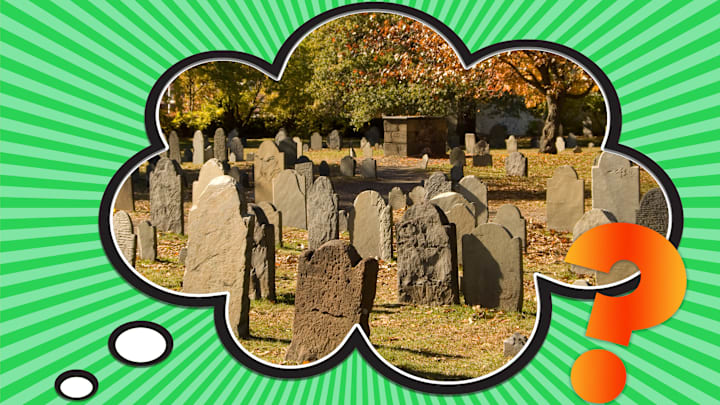Eventually, we’re all going to end up in a graveyard. Or is that a cemetery? What’s the difference, anyway?
These days, the answer is “not much.” Both are places where we bury the dearly departed, and the words are often used interchangeably. But that hasn’t always been the case—in fact, the words’ meanings have sort of flip-flopped.
The Big Switch
Cemetery is the older of the two words; it’s derived from the Latin coemētērium and first appeared in the mid-1400s. According to the Oxford English Dictionary (OED), it “Originally applied to the Roman underground cemeteries or catacombs,” or galleries with tombs for bodies along the sides. The first known use from J. Capgrave’s Abbreuiacion of Cronicles, is just barely legible today: “Anicetus ... was biried in the cymytery of Kalixt.”

Over time, the meaning of cemetery shifted from the underground catacombs to burial grounds closer to the surface, and by 1485, it had come to refer to the consecrated ground next to a church, a.k.a. a churchyard (a usage that, per the OED, is now obsolete). Since the 1600s, cemetery has referred to a more general burial ground, particularly “a large public park or ground laid out expressly for the interment of the dead, and not being the ‘yard’ of any church,” according to the OED. Think of places like Paris’s Pere Lachaise or Brooklyn’s Green-wood Cemetery, which were both planned with the express purpose of serving as burial grounds for large amounts of people, no matter their religious inclination.

Graveyard is a newer word, and was initially a much more religiously neutral one: When it first popped up in English in the mid-1700s, it simply meant “a burial ground.” The OED pinpoints 1767 as its first use, when it appeared in P. V. Fithian’s Journal & Letters: “He meant it for a Satire upon the neglect of the people in suffering their Grave-Yard to lie common.”
While “burial ground” remains the OED’s sole meaning for graveyard, other sources—including some funeral providers, Dictionary.com, and the Huffington Post—say that these days, the word refers to smaller burial areas near churches. As Titan Casket puts it, “Graveyards are often associated with churches and are thus always located on church grounds. Owing to land limitations, graveyards tend to be smaller in size, and are, therefore, more challenging to secure. In most cases, graveyards only allow members of the same religion, and more specifically, the same church, to be buried on their premises.”
A Graveyard of Metaphors
The biggest difference between cemetery and graveyard—at least, linguistically speaking—may be that the latter is used more often in metaphors. Since the mid-1800s, examples have been found in print of figurative graveyards, as the term has proven an apt signifier of final resting places of all sorts. A 1969 use in The Daily Telegraph is typical of this sense: “The M1 motorway was a graveyard of cars abandoned across all six lanes.”

Such comparisons are very common, as seen in recent news stories that refer to a “graveyard of unique architecture,” “the graveyard of empires,” a “Halloween Graveyard for QB Victims,” a “graveyard of bottles,” a “graveyard of education,” and a movie described as a “Graveyard of Loose Ends.”
There’s also graveyard shift, a somewhat spooky term for a portion of a job performed at night. That term is first found in a 1907 issue of Collier’s: “From the saloons came the clink of the chips. For it was the ‘grave~yard gamblers’ shift... The small hours of the morning ... are theirs.”
Discover More Answers to Big Questions:
